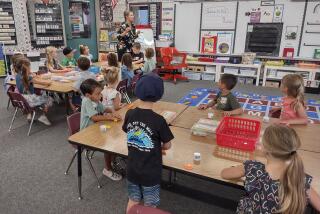California’s Textbooks
* Re “Good Framework for Textbooks,” editorial, Dec. 27:
In the marketplace of our free society, merchants provide huge arrays of products to best meet each individual consumer’s needs. In any supermarket, for example, each consumer can choose from different types of shampoo, toothpaste, toilet paper, etc. The choices provided to satisfy each consumer’s dietary needs are immense--a variety of fruit juices, different types of lettuce, great diversity of apples, many kinds of pastas, a full aisle of all sorts of bread. Satisfied consumers continue buying their favorite brands or new brands that better meet their needs.
Not so in education. By law, all California public schoolchildren shall be taught to read in English in exactly the same manner through the same exact method--phonics--using only one of the reading series from the “two or three” reading textbooks soon to be adopted by the state. The Times hopes that one of these shall work “with young pupils no matter what language they speak at home or their degree of preparation when they start school.”
As a result of this extremely regimented instructional program, all children shall learn to read “with comprehension and enthusiasm.” Really?
CARMEN SANCHEZ SADEK
Los Angeles
* As a veteran first-grade teacher, I have followed your “Reading by 9” series with great interest. Obviously a lot of research has gone into the articles. However, one piece of information left out of this editorial is the fact that the “excellent new reading and language arts framework” is being released after public school districts have spent millions of dollars on new reading and language arts textbooks in the last two years. Districts only do this every seven years, so there won’t be textbook purchases that reflect the changes in the new framework any time soon.
SUSAN S. DUTCHER
Fullerton


